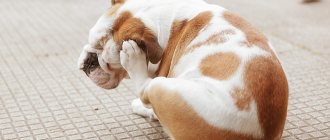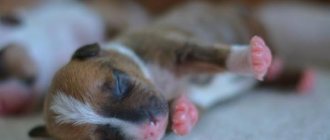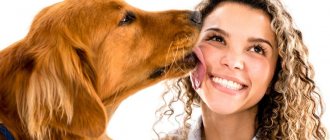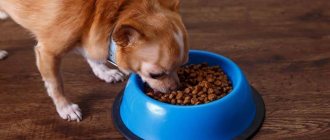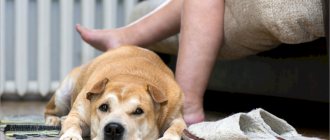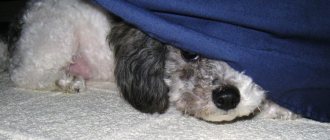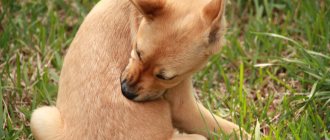Causes of the disease
The disease is characterized by acute and chronic forms.
The causes of orchitis can be:
- infections with a viral pathogen (plague, brucellosis, jaundice);
- infections of a bacterial nature (inflammation of the bladder - cystitis; inflammation of the prostate - prostatitis);
- damage to the scrotum area as a result of insect bites;
- inflammatory processes in the skin (dermatitis) in the testicular area;
- pathologies of the genital organs (for example, torsion of the spermatic cord);
- dropsy of the testicles (hydrocele);
- malignant tumors;
- autoimmune diseases.
Causes of genital licking in bitches
In female dogs, abnormal vaginal discharge can lead to excessive licking. Vaginal discharge is any substance that comes (flows) from the labia (external female genitalia). Vaginal discharge can be a normal part of the dog's heat cycle or a normal occurrence during the postpartum period, sometimes lasting 6 to 8 weeks. Causes of excessive abnormal discharge include:
- Urinary tract infections (urinary tract infection, pyometra/infected uterus).
- Neoplasia (cancer) of the urogenital tract.
- Vaginitis (inflammation of the vagina) or inflammation in the genitourinary tract.
- Coagulation (clotting) disorders (associated with rat poison, low platelet levels).
- Trauma or foreign body of the urogenital tract.
- Urinary incontinence (inability to hold urine) secondary to an ectopic (abnormally positioned) ureter or a problem with the sphincter (tissue that acts like a door to control urine output).
- Retained placenta (the organ that connects the fetus to the lining of the uterus) or fetal death. The presence of genital discharge most often indicates an underlying problem, ranging from a mild, relatively benign condition to a severe, even life-threatening illness.
What to look for
- Excessive licking
- spotting
- Swelling of the genital organs
Which breeds are more susceptible
There is a risk of disease in breeds susceptible to various types of dermatitis if the focus of skin inflammation is located in the area of the testes. Dogs of large and massive breeds (German and Dogues de Bordeaux, Mountain Dogs, Newfoundlands and others) are prone to dermatitis.
However, the possibility of illness in a dog of any breed cannot be ruled out. All breeds and ages of dogs are susceptible to orchitis, but in most cases adults are affected.
List of drugs and antibiotics
Here is an approximate list of drugs and antibiotics used in the treatment of orchitis:
- For novocaine blockades, novocaine is used in the form of a 0.5% solution. It must be warm and fresh, otherwise there will be no pronounced therapeutic effect.
- Antibiotics are used from the cephalosporin group (Ceftriaxone, for example), but in severe cases, drugs from the tetracycline group (Doxycycline) may be required. When performing novocaine blockades, benzylpenicillin sodium salt can be used.
- Multivitamin preparations - Tetravit, Vittri, Trivit, Stride Plus.
- Regular analgin can be used as a pain reliever.
Main symptoms
Symptoms of a dangerous disease that occurs in acute form:
- swelling of the testes;
- pain when moving;
- the skin of the scrotum acquires a red-blue tint;
- swelling of the scrotum;
- the skin on the scrotum is irritated, the male constantly licks it, which contributes to the formation of wounds;
- drowsiness, immobility;
- refusal to eat;
- increased body temperature;
- restless behavior;
- difficulty urinating.
In the chronic form of the disease, the animal experiences:
- soreness;
- hardening of the testicles;
- increased temperature of the painful area;
- discomfort.
What is orchitis and why is it dangerous?
Orchitis is inflammation of the testes. But! Only testes. Inflammation of the appendages is called epididymitis, and mixed pathology is called epididymitis orchioepididymitis. However, in practice, these pathologies are so interrelated that veterinarians still call them “orchitis”, regardless of the tissues involved in the inflammatory process.
Why is orchitis dangerous?
- Males very often remain infertile. For professional breeders and in the case of pets of rare breeds, this is a very unpleasant circumstance.
- In animals that have recovered from the disease, there is a decrease in testosterone levels . This, firstly, often leads to the impossibility of using them for breeding purposes. Secondly, a decrease in the level of sex hormones in itself is dangerous for the dog’s health, as we have already written about above.
- The testes are connected to the abdominal cavity by the inguinal canal. And if inflammation develops in the gland tissue, pathogenic microflora may well get there. In almost 100% of cases, this leads to severe peritonitis, often ending in the death of the pet.
Diagnostics in a veterinary clinic
To exclude the development of a dangerous disease and minimize the risk of infertility, it is necessary to consult a doctor without delay.
The veterinary clinic performs an external examination of the pet with palpation.
Tests ordered:
- urinalysis, urine culture;
- Ultrasound of the testes, testicular appendages and prostate gland;
- general blood analysis;
- blood chemistry;
- blood for brucellosis (to exclude a dangerous infectious disease);
- material from an open wound for the presence of bacteria;
- fluid from the testes;
- bacterial culture of the prostate;
- sperm (if the doctor decides).
With infectious orchitis, a blood test will show a large number of white blood cells; with cystitis or prostatitis, protein, blood, pus, and proteins are present in the urine.
If there are open wounds, the doctor will order a test for bacterial infections.
Based on the results of the examination, the doctor makes a diagnosis.
Treatment for genital licking in dogs
Your veterinarian may recommend several things to treat a patient with genital discharge and excessive licking.
- Eliminate or treat any obvious trigger or underlying cause, such as a foreign body, tumor, or infection.
- Vaginitis in young dogs usually goes away after the first heat; therefore therapy is not indicated
- In many cases, daily washing and cleansing of the vagina or foreskin may be helpful.
Take all prescribed medications as directed by your veterinarian and monitor your pet closely. If clinical signs do not improve or worsen, contact your veterinarian immediately.
Treatment method and prognosis
Depending on the diagnosis, the pet is prescribed treatment.
If the animal is in severe pain, analgesics are prescribed for pain relief.
Based on the results of determining the type and sensitivity of microflora, antibiotic therapy is prescribed. If necessary, antihistamines are added to relieve swelling.
Also, pain can be reduced by cooling ointments, which should be recommended by a doctor. Using ointments on your own can irritate the sensitive skin of the scrotum and lead to eczema.
During the treatment period, it is necessary to protect the scrotum with inflamed testes from accidental injury, as well as from the dog licking the medicinal ointment. To do this, you can sew it yourself or buy a protective bag (suspensor) at the pharmacy.
In the early stages, orchitis can be treated quite safely.
In its advanced form, orchitis always inhibits the formation of sperm, which can lead to infertility in a male dog, despite a favorable outcome of treatment. In this case, at the end of treatment, it is recommended to take a fertility test.
A severe form of the disease, aggravated by damage to the entire body by an infectious pathogen, is often an indication for surgical intervention - castration of the pet.
In older male dogs, the chronic form of the disease is more common, which can develop into tumor processes. If over time the volume of the affected testis increases, then castration is definitely recommended.
Functions of the testes in the body
What functions of the testes in the body are most important?
Biologists and veterinarians find it difficult to answer this question, since the importance of these organs is difficult to overestimate:
- Reproductive. Spermatozoa mature in the testes and appendages of the organ. If there is something wrong with them, the sperm are “born” non-viable, with congenital developmental anomalies, they can no longer “make their way” through the female’s reproductive tract and cannot contribute to conception. Another option is that fertilization occurs, but the puppies are subsequently born non-viable, with a whole “bouquet” of genetic developmental anomalies.
- Hormonal. It is these organs that secrete testosterone, on which the dog’s health directly depends. In particular, if there is a lack of this hormone, the pet develops obesity, becomes apathetic, the amount of muscle tissue decreases, etc. An excess of testosterone is also extremely harmful, since in this case the risk of developing pathologies of the heart and blood vessels sharply increases.
What to do at home
During treatment, the animal must be kept at rest and physical activity excluded.
Treatment at home must be carried out according to doctor's prescriptions.
Medicines should be stored depending on the instructions in the instructions. If stored in the refrigerator, the medication must be at room temperature before use. The drug should “heat up” naturally. Any artificial increase in temperature can cause the destruction of the active substance of the medicine.
Indecent behavior
Sofia Baskina's article was first published in the magazine My Friend Dog in January 2011. Photographer: Voinilovich M.
In the article:
- About sexual behavior in dogs
- About cages per person
- How to deal with them
- How to distinguish a dominant cage from a sexual cage
- About the influence of castration of a male dog at a given age on his behavior in the future
60% of dogs do “this.” Some owners are amused and encourage their pet, others are embarrassed and blush, and others severely punish. And dogs are not shy about landing on pillows and toys, as well as on the feet of their beloved owners and their guests. Usually, owners cope with “indecent behavior” quite easily and only occasionally does it become a serious problem. Why do dogs choose humans as objects of desire? And what to do with it? This is what our article is about.
Love or enmity?
Evolutionary psychologists are also interested in why sexual behavior is perceived as obscene in human society. The intended humiliation of the person at whom sexual behavior is directed is reflected in obscene curses in various languages of the world. Maybe this is why people are so willing to support the myth that dogs mount their relatives and people in order to gain a dominant rank. In reality, cages in which a male dog demonstrates dominance or challenges an opponent are very different from cages of sexual behavior. A male claiming a dominant position rests his chin on the withers of another male, then puts his paws on his back, mounts him on the opponent’s shoulder and makes movements with his pelvis, reminiscent of friction during a sexual mount. With such a display of dominance, there is no erection, which is usual for sexual mounting.
But if a dog mounts another dog not for the purpose of humiliating his opponent, then why does he do it? Scientists know of only a few cases of persistent homosexual preference in male dogs [2]; in the vast majority of cases, same-sex matings occur due to the inexperience of both partners and in the absence of relatives of the opposite sex. The fact is that mating, as an element of an innate behavior program, is triggered by certain stimuli: the smell of a bitch ready for mating, her appearance and behavior. While the male dog has no sexual experience, a whole range of different stimuli can lead to sexual arousal, almost any new unusual smell or something in shape suitable for grasping with the front paws.
Starting from 6-8 months and up to 12 months, the level of testosterone in the blood of a male dog increases, then the concentration of this hormone begins to decrease, but the persistent preference of the female in the “hunt” over the one that is not ready for mating continues to form for another six months [4 ]. Only after several matings does the stimulus generalize, i.e. For the rest of his life, a male dog remembers the “signs” of a sexual object, as well as everything that surrounded him at that moment: whether it was a room or a street, etc. That is why breeders prefer that a bitch in a state of “hunting” be brought to the house where the male lives. In this case, the male dog will be less likely to try to run away and join the yard “dog wedding,” although this does not always work. At the same time, an experienced stud dog usually calmly treats females in heat outside the “hunting” period, follows them, but does not try to mate until she is ready for mating.
Puppy romp
When playing with their relatives, puppies begin to make movements similar to mating - mounting - at the age of 3 to 6 weeks after birth [5]. It is clear that sexual behavior is very important for a dog, because its main goals, like those of any animal, are to survive and leave offspring. In the game, puppies rehearse all those situations that
may happen in their future lives. They learn to court or accept advances from members of the opposite sex. Dogs that were not allowed to play as children often experience difficulties when mating: they can be overly aggressive towards their partner, some bitches will fall on their backs squealing as soon as the male puts his paw on their back. An inexperienced male sometimes plays with a bitch without showing any sexual desire at all. Sometimes he makes characteristic movements with his pelvis, standing next to the bitch, or mounts her, but from the side or in front [3]. Puppies of any sex do cages, but males do cages more often and prefer to play with bitches this way rather than with males [1].
Sexual behavior in dogs is not limited to cages. A dog, caring for a bitch, licks her lips, eyes and ears, falls on her front paws, as if inviting her to play, touches her shoulder with his nose, licks the “noose” or urinary mark left by the bitch. At the same time, his lower jaw trembles a little, and his gaze seems frozen. At this moment, the male applies his tongue with urine applied to it to the holes in the palate leading to the vomeronasal (Jacobson) organ. With the help of the vomeronasal organ, the male detects pheromones and determines the female’s readiness for mating [5]. The vomeronasal organ plays a major role in the formation of attachment, not only between dogs and dogs, but also between dogs and people. This explains the craving of domestic dogs to lick the owner’s skin - this is how they remember our individual smell and establish a lasting attachment to us.
Behavioral reasons for deviations
At the age of six months, male dogs often try to “crush” soft toys, the sides of their beds, or steal the owner’s pillows. At the same time, they begin to mount the owner’s arms or legs during play. In my opinion, dogs are able to direct sexual behavior towards a person because they imprint the owner at an early age along with other living beings from their environment: dogs, cats, etc. They seem to perceive a person as a little dog or themselves as a little human. When choosing an object of attraction, a male prefers his relatives, but in the absence of them nearby, he mounts “strange two-legged half-dogs.” In some cases, however, this behavior in dogs is provoked by the preservative methylparaben, which is part of some products and cosmetics [7]. For us, its smell, mixed with other odors, is imperceptible, but for a dog’s nose, which is able to identify the components of the odor mixture, methylparaben is close to the smell of a female dog in heat and evokes corresponding associations.
Physiological reasons
Veterinary clinic traumatologist Alexander Zotov names 3 main physiological reasons for increased sexual desire in dogs: lack of exercise, overpopulation of dogs in the city and hormonal disorders. A young dog needs at least 3 hours of walks a day, but not all owners find the time for this. The dog gets bored at home, languishes from an excess of unspent energy, and since the owner does not try to keep the pet busy, the dog finds something to do on his own. He can howl, chew furniture, tear apart carpets by thread, and can make cages, receiving not only physical pleasure, but also the attention of the owner, even if in most cases it is negative. If the dog is not well-mannered and the owners cannot control him, he reacts aggressively to any prohibition, as a result the owners are afraid to push the “lustful monster”, because he will begin to growl and bite. And yet this is precisely sexual behavior, and not an attempt at dominance, since the male usually begins by licking his hands, grabbing them in his mouth, biting them lightly, then his movements become more active and purposeful, and he makes a mounting. Often he gets an erection before mounting or even without mounting at all.
The ancestors of dogs, like other domestic animals, reproduced in a certain season, the most favorable for raising offspring in given climatic conditions. In most breeds of domestic dogs, seasonality has disappeared; bitches can come into heat at any time of the year. It turns out that the male constantly, throughout the year, finds the scent of one or another bitch in the “hunt”. The male becomes overexcited, often refuses to eat, tries to run away while walking, and sleeps poorly. But all this happens not once a year (which would be natural for his species), but almost every month. Obesity due to lack of physical activity and “bursts” of sexual activity lead to hormonal disorders, and these, in turn, lead to an obsessive desire to get pregnant for something.
Bitches also do cages. They may even spend considerable time doing this activity and urinate from excitement. Often, older females begin to chase other females in heat, as well as males, and mount them. The interest of bitches in the smell of their companions in the “hunt” is normal behavior, while the obsessive desire for cages at an older age in bitches is often a consequence of hormonal disorders, which simultaneously lead to other diseases, such as false pregnancy, neoplasms on mammary glands or in the uterus.
Effect of castration
If a dog's obsessive attempts to mount all people within reach become a problem, dog owners are often advised to neuter their pet. In a series of studies, scientists compared the behavior of non-operated male dogs with the behavior of male dogs castrated at a given age [1,4,5,6,8].:
Table
How should an owner react to cages?
If the owner stubbornly, every time the dog sits on him, forbids it to continue, gradually the dog stops doing them altogether. For example, even castrated males can carry out cages if the owner smells of new perfume or behaves unusually for a dog, for example, dancing. When dealing with a dog that is not too heavy, it is often enough to simply raise your leg or arm higher,
which the dog is trying to attach himself to, so that he loses his balance and stops trying. The owner can also send the dog to its place or command “Lie down!” every time her behavior goes beyond the “bounds of decency.” It is better to remove or throw away objects on which the dog sits, otherwise over time the pet may begin to protect them, just like tasty bones or favorite toys. In addition, they preserve the dog’s habit of having fun in this way.
You should not encourage your dog or laugh at his attempts, as he will perceive this as reinforcement. It also makes no sense to push it away too harshly or harshly punish it; do not forget that mounting usually begins with the dog licking the owner’s hands, and this contributes to its attachment to you. All the owner needs to do is show the dog the boundaries from which he should not go.
Although correcting deviant behavior is relatively simple, the problem should not be ignored. Frequent sitting on people or objects is an alarming “bell” indicating that your dog is not well. She lacks attention, physical and mental stress. The life of a pet dog revolves around its owner; it has no “business of its own” that it could do while people are not interested in it, except, of course, for those bad habits that ultimately make coexistence with it unpleasant.
Case from practice
A strange problem has appeared in the behavior of a young male wheaten terrier. Returning from an evening walk with his owner, after washing his paws and feeding, he became extremely excited and began to attack his owner, who at that time was usually relaxing in front of the TV. The dog continuously sat on his arms or legs. The dog was extremely persistent, did not react to prohibitions and spankings with a newspaper - he jumped back, returned and resumed his old ways. Only after an hour did he calm down, stop trying and fall asleep. On walks, he tried to mount all the dogs, but not so persistently. The walks themselves were quite long, but not particularly active: due to their age, the owners could not provide the terrier with high physical activity. To get rid of problem behavior that had become a bad habit for the dog, we used tethering punishment. After a walk, the dog’s collar was not removed, and as soon as the dog tried to mount the owner, he was taken on a leash and tied short to the leg of the sofa. The length of the leash allowed the dog to stand, but did not allow him to jump onto the sofa and continue to pester the owner. For some time the dog whined, tried to escape, and chewed the leash. Then he sat down. At this moment he was untied, calmly praised and released.
If the terrier attempted to mount again, he was again tied briefly and kept on the leash until he sat or lay down. The first days the terrier calmed down within 2-3 minutes and needed to be tied up 3-4 times per evening. After a week, a single tie-down for a couple of minutes was enough. After two weeks, it was often enough just to get the leash, and the dog obediently lay down on the sofa, without resuming attempts to mount the owner. After 2 years, the owner tells the following about the dog: “If tutors come to my granddaughter and the dog is in the way, I put “that” red leash on him and his behavior changes dramatically. He immediately lies down next to my chair and does not pay attention to the guests. He doesn’t pester or jump on people, neither his own nor strangers. Maybe this only happened to him a couple of times a year. But he still haunts one favorite pillow that we usually try to hide. On walks, he no longer pesters everyone, but only bitches in heat, he figured it out, you can see what’s what. Of course, compared to the previous dog, you still have to watch him more carefully, otherwise he tries to run away. We bred the old one, but he still wasn’t particularly interested in bitches. We still love the current terrier very much, we think we just came across such a specimen!”
1. Overol K. Clinical methods for correcting the behavior of dogs and cats. M.: Sofion, 2005.
2. Barton A. Sexual inversion and homosexuality in dogs and cats // Vet. Med. 1959. Vol.54, P. 155
3. Beach FA Coital behavior in dogs. III. Effects of early isolation on mating in males // Behavior. 1968. Vol.30, N 2. P.218-238
4. Beach FA, Buehler MG, Dunbar IF Development of attraction to estrous females in male dogs // Physiology & Behavior. 1983. Vol. 31, pp. 293-297.
5. Beaver BV Canine Behavior: Insights and Answers (SECOND EDITION). Elsevier. 2009
6. Hart BL Behavioral effects of castration // Canine Practice. 1976. Vol.3. N.3. P. 10-21.
7. Mertens PA Reproductive and sexual behavioral problems in dogs // Theriogenology. 2006 Vol. 66. P. 606–609
8. Olson PN, Pouliot M. Guide dog schools: A model for interdisciplinary studies on canine behavior // Proc Third International Congress Vet Behav Med. 2001. P. 69.
Why does a dog lick its owner?
A dog licks its owner not only on a wave of emotions. In most cases, such behavior is explained by ordinary instincts.
Expression of love and affection
Quadrupeds express their love and affection not only with their tongue, but also with the rest of their body. When they meet their owners from work, they happily wag their tails and insistently try to jump on their arms. Contented squeals and welcoming barks are added to the body language.
Feelings of fear or loneliness
Licking is a great way to attract attention. Animals use it when there is a lack of communication and anxiety.
Many four-legged animals cannot stand loneliness. Don’t be surprised by their strange behavior if you often miss work and don’t devote enough time to your pets.
If your dog whines, clings to you and licks your face, then he is most likely scared. The cause of stress is often a thunderstorm or a sudden explosion of firecrackers under the window. Both phobias can be corrected.
It is worth thinking seriously only when the animal behaves too timidly, tries to keep a safe distance and shows submission at every opportunity. In such a situation, the cause of fear is frequent aggression on the part of a person: physical punishment and constant screaming.
Such methods of education do not lead to anything good. They only undermine the connection between the owner and the pet, break the four-legged psyche and cultivate cowardice and aggressiveness in it.
Way to collect information
By licking people, dogs collect the most detailed information about them. The tongue of tetrapods contains many sensory receptors. With their help, they determine the mood and well-being of the “interlocutor”. This helps you choose the ideal model of behavior: continue communication, be wary, or attack.
Manifestation of instinct
When begging for food from their mother, the puppies actively lick her face. This instinct persists even into conscious age. Only the role of mother at this moment goes to the person. If a dog licks his hands and face, then most likely he just wants to eat.
I like the taste and smell of a person
Four-legged pets are very sensitive to odors, and a pleasant aroma is often accompanied by a similar taste. A person is a real find for them. He constantly smells like delicious food, creams or perfume. Animals are especially delighted by the smell and salty taste of sweat.
The opposite situation also occurs. If the smell causes rejection, the animal tries to get rid of it using its tongue. In this way, the dog shows his jealousy by smelling the smell of a previously petted cat on the owner.
Childhood habit and bad parenting
Puppies lick their nursing mother not only because of hunger. This is how they show their love and affection. After the owner appears, all the laurels go to him, since the childhood habit does not disappear anywhere.
Another possible reason is manipulation due to poor upbringing. Encouraging affection with treats always leads to begging. The dog quickly remembers the relationship and begins to extort sweets with his touching behavior at any opportunity.
Showing sympathy, trying to cure a person
Four-legged pets are empathetic. When they notice a crying person, they always try to cheer him up with their tongue.
In addition to sympathy, do not forget about healing. Licking wounds is inherent in animals at the level of instincts. Don't be surprised if your dog tries to treat your scratches with his tongue. In this way he expresses his love and care.

